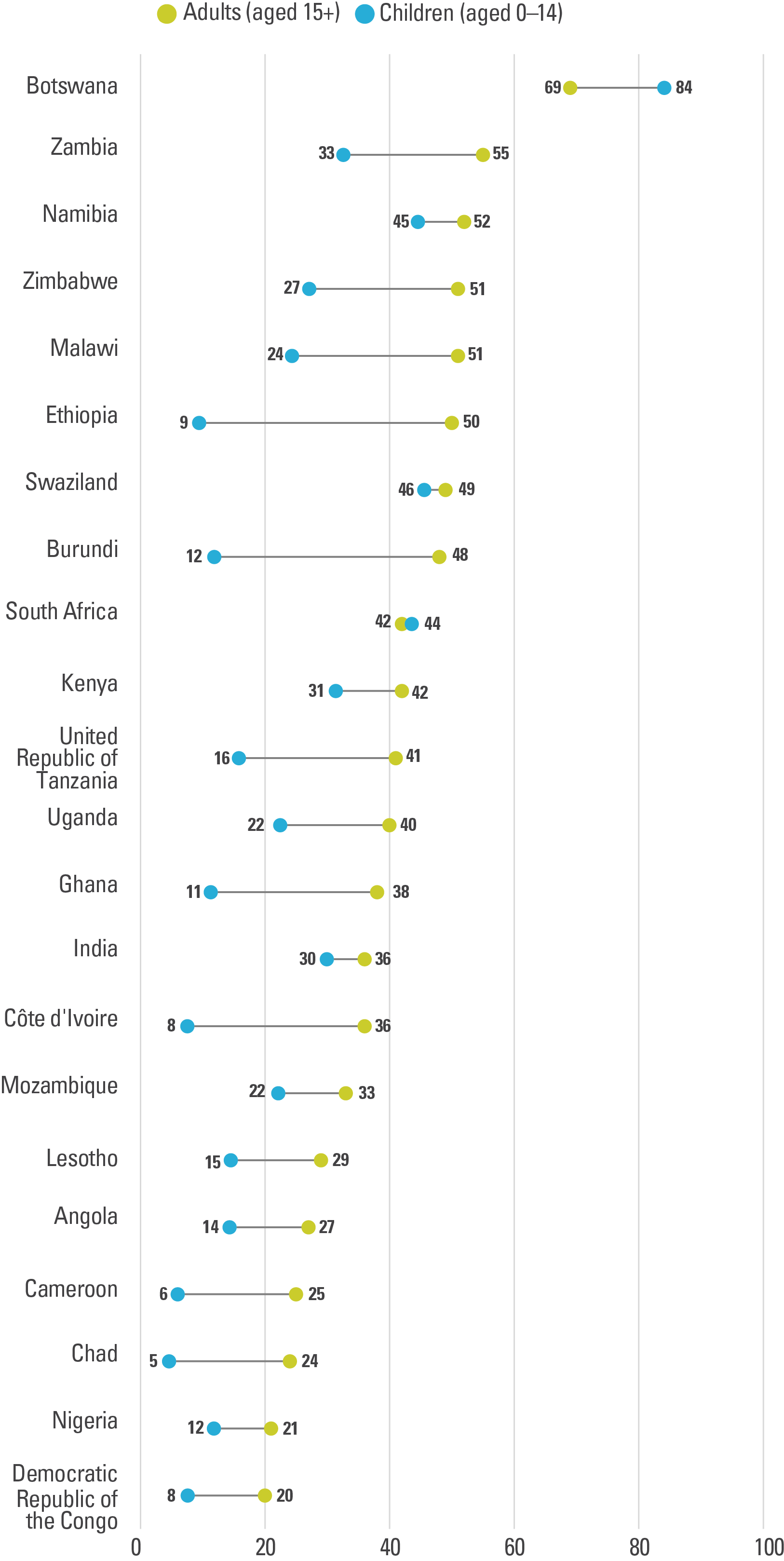Globally, children under age 15 account for about 9 per cent of all people living with HIV, 11 per cent of new HIV infections and 13 per cent of all HIV-related deaths. Children under 1 year of age are among those most vulnerable to HIV and among the least served by treatment and care services. Evidence shows that early initiation of antiretroviral drugs in infants with HIV can save lives. Yet coverage among children remains too low – 23 per cent in 2013. Antiretroviral treatment services will have to expand rapidly if the ‘Unite for Children, Unite against AIDS’ goal of providing universal access to antiretroviral treatment to all children in need by 2015 is to be achieved.
HIV PREVALENCE IN CHILDREN
An estimated 3.2 million children under age 15 were living with HIV in 2013. Of these, 240,000 were newly infected within the year, mainly through transmission of the virus from their mothers during pregnancy, delivery or while breastfeeding. Over 90 per cent of children living with HIV are in sub-Saharan Africa.
Because the virus progresses rapidly in infants, early treatment is vital to their survival. Without treatment, one third of children living with HIV will die in their first year of life, rising to almost half by age 2. International guidelines advise that immediate antiretroviral therapy is crucial if HIV infection is detected in infancy. In reality, most children entering treatment programmes are older.
In 2013, an estimated 190,000 children died of AIDS-related causes. The vast majority of these deaths were preventable, either through antibiotic treatment of opportunistic infections or through antiretroviral treatment. That said, coverage of antiretroviral therapy in children under age 15 is one third less than that of adults.
PROGRESS
In 2013, about 740,000 children under age 15 were receiving antiretroviral therapy in low- and middle-income countries, up from about 360,000 in 2009 and 200,000 in 2007. This means that only about a fourth of children under age 15 living with HIV are receiving ART (23 per cent).
In 2013, regional coverage of eligible children under age 15 receiving antiretroviral therapy varied widely, ranging from 10 per cent in West and Central Africa to greater than 95 per cent in Central and Eastern Europe and the Commonwealth of Independent States (CEE/CIS). In sub-Saharan Africa, 22 per cent of children living with HIV received treatment, though wide disparities are found among subregions: coverage was 27 per cent in Eastern and Southern Africa and only 10 per cent in West and Central Africa.
Early diagnosis and treatment is particularly critical in the case of newborns. In fact, the ‘Children with HIV Early Antiretroviral Therapy’ study from South Africa shows a 76 per cent reduction in mortality when treatment is initiated in the first 12 weeks of life among infants who test positive for HIV.
Countries have made good progress in expanding access to HIV-testing services at the point of care. However, the uptake of HIV testing among children worldwide remains low, at only 37 per cent, and progress has slowed in recent years. The revised treatment guidelines of the World Health Organization (WHO) recommend that infants, if HIV-exposed, should be tested by 4 to 6 weeks of age using virological assays. Those found positive should be started on antiretroviral therapy immediately upon diagnosis. Low treatment coverage is also reported among HIV-exposed infants in low- and middle-income countries who are started on cotrimoxazole prophylaxis (37 per cent) and among those receiving antiretroviral prophylaxis to prevent mother-to-child transmission (51 per cent).
For more data and analysis on HIV and AIDS in children, see UNICEF’s Children and AIDS: Sixth stocktaking report by clicking here.
REFERENCES
UNICEF, Children and AIDS: Sixth stocktaking report, UNICEF, New York, 2013.
UNAIDS, Report on the Global AIDS Epidemic, UNAIDS, Geneva, 2013.
UNAIDS, Global AIDS Response Progress Reporting 2014. Guidelines: Construction of core indicators for monitoring the 2011 Political Declaration on HIV/AIDS, UNAIDS, Geneva, 2014.
UNICEF, Progress for Children: A report card on adolescents, No. 10, UNICEF New York, 2012.
UNICEF, Progress for Children: Achieving the MDGs with equity, No. 9, UNICEF New York, 2010.
UNICEF, The State of the World’s Children 2014 in Numbers: Every child counts – Revealing disparities, advancing children’s rights, UNICEF, New York, 2014.
UNICEF, The State of the World’s Children 2013: Children with disabilities, UNICEF, New York, 2013.
UNICEF, UNAIDS, UNESCO, UNFPA, ILO, WHO and The World Bank, Opportunity in Crisis: Preventing HIV from early adolescence to young adulthood, UNICEF, New York, 2011.
WHO, Global Update on HIV Treatment 2013: Results, impact and opportunities, WHO, Geneva, 2013.
WHO, UNAIDS and UNICEF, Global HIV/AIDS Response: Epidemic update and health sector progress towards universal access – Progress report 2011, UNAIDS, Geneva, 2011.




